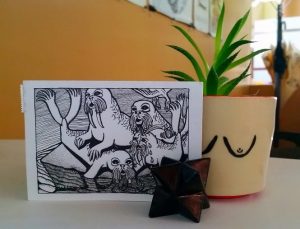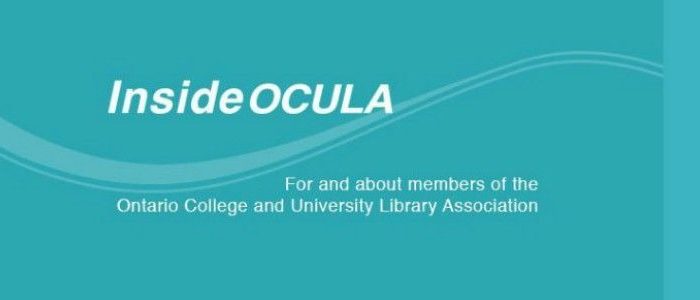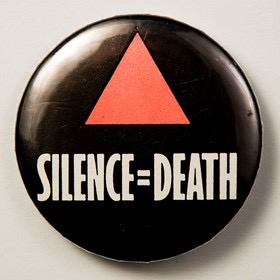
Spinning Stories: the Role of Storytelling in our Work
On my office desk sits a postcard. It’s a single panel from a pen and ink comic telling the tale, as the artist describes it, of the “trials and tribulations of walrus friendship”. The postcard depicts one walrus stabbing another with its tusks; the other walrus cries big tears (as one would when stabbed by a trusted friend). The comic is aptly titled Walrus Dispute.

The sender of the postcard, a trusted friend of my own, writes on the back, “this walrus cuddle party made me think of you”. I choose to believe that my friend has simply misinterpreted the comic, rather than sent an ominous warning my way.
I keep this postcard on my desk because the art is lovely, because I miss my friend, and because it reminds me that the stories we think we tell—through our words, our art, our profession—may not be the stories we’re actually telling.
This year’s OCULA Spring Conference, with its focus on “Using Narrative to Represent Ourselves, Our Work, and Our Libraries”, was a perfect opportunity to reflect on the ways storytelling is embedded in our work. Sage Tyrtle, the keynote speaker and a master storyteller, began the day by sharing the tale of Baba Yaga—as a (hopefully fictional) chicken-footed monster that dines solely on well-meaning librarians. The lightning talks that followed were illuminating, and merited far more than the 7 minutes each they were allotted, initiating thoughtful conversations around privacy, visual storytelling, empathy in the workplace, and the stories we tell through our collections. Spending the day discussing how our work intersects with storytelling and narratives was enlightening and inspiring, and a welcomed opportunity to articulate—through stories—why we do what we do.
In her time with us, Sage shared some trade secrets behind telling a good story. While college and university libraries rarely host storytime, narratives—the ones we tell, the ones we participate in—significantly inform the work we do. So, I thought I would take this opportunity to pass on some of Sage’s advice, and reflect on how I engage with stories through my work.
Leave out the bits that don’t matter to your audience
The stories we tell are as much about us as they are about the people we tell them to.
The same principle applies when I teach my students about data visualization, copyright, science communication, etc. Approaching instruction as a form of storytelling keeps me focused on not just what I teach, but how and why I teach it (two questions that are usually far more interesting to both myself and my students). Similarly, when reaching out to faculty and instructors in the hopes of forming relationships, I think about how to frame a proposed partnership in a way that focuses on their interests rather than just my own.
Telling stories together is more fun (and effective)
Stories that encourage participation from the audience resonate more deeply. The audience is now a stakeholder, another storyteller in the process; the narrative is not just yours, but controlled, at least partially, by the people you share (or tell) it with.
Collaborative storytelling has implications at a strategic and organizational level—what story is the library, as an institution, telling, and who are we telling it with? However, as an instructional librarian, I primarily use this practice in the classroom. For example, in my lessons about source evaluation and copyright, I share legal cases and ask students to think about what legal arguments are in play and what the case outcome should be. Collaborative storytelling is an easy and effective way of getting students not only talking to one another and myself, but also invested in the instructional content as well.
Everyone, everything has a story
Professionally, I interact with stories every day. As much as I like telling stories, consuming stories is my favourite part of the job. Coworkers, faculty, and students are all wonderful sources, and greatly inform me both about institutional culture as well as the efficacy and impact of my own work (an instructor sharing a personal story tells me more about the strength of our partnership than a positive score on a survey). That being said, I am particularly interested in the stories embedded in objects and spaces. What intrinsic hierarchies are in place in traditional lecture halls—and how do I destabilize them? What do security cameras and security presence signify in libraries? What policies are in place, and who do and don’t they serve?
Recognizing that stories are embedded everywhere helps me be deliberate about the stories I choose to participate in and tell, and better understand the narrative my institution and library are trying to craft. As it is, stories resonate with people far more than policies do.
Abeer Siddiqui is the School of Interdisciplinary Science Librarian at McMaster University. She can be reached at siddia33 [at] mcmaster.ca.
This Post Has One Comment
Comments are closed.



any suggested reading to engage the storytelling aspect at universities and colleges?